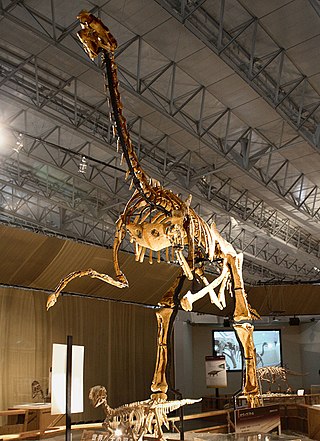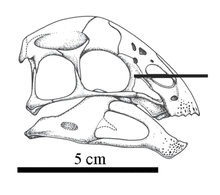
Jeholosaurus is a genus of neornithischian dinosaur from the Early Cretaceous Period. It is thought to have been a herbivorous small ornithopod.

Nemegtomaia is a genus of oviraptorid dinosaur from what is now Mongolia that lived in the Late Cretaceous Period, about 70 million years ago. The first specimen was found in 1996, and became the basis of the new genus and species N. barsboldi in 2004. The original genus name was Nemegtia, but this was changed to Nemegtomaia in 2005, as the former name was preoccupied. The first part of the generic name refers to the Nemegt Basin, where the animal was found, and the second part means "good mother", in reference to the fact that oviraptorids are known to have brooded their eggs. The specific name honours the palaeontologist Rinchen Barsbold. Two more specimens were found in 2007, one of which was found on top of a nest with eggs, but the dinosaur had received its genus name before it was found associated with eggs.

Gigantoraptor is a genus of large oviraptorosaur dinosaur that lived in Asia during the Late Cretaceous period. It is known from the Iren Dabasu Formation of Inner Mongolia, where the first remains were found in 2005.

Zhongyuansaurus is a monospecific genus of ankylosaurid dinosaur from Henan that lived during the Early Cretaceous in what is now the Haoling Formation. Zhongyuansaurus is possibly a junior synonym of Gobisaurus, a basal ankylosaurid from the Ulansuhai Formation of Inner Mongolia.

Luanchuanraptor is a genus of dromaeosaurid theropod dinosaurs from the Late Cretaceous of China. The genus is based on a partial skeleton from the Qiupa Formation in Luanchuan, Henan. They were medium-sized dromaeosaurids, the first Asian dromaeosaurid taxa described from outside the Gobi Desert or northeastern China.

Qiupalong is a genus of extinct ornithomimid theropods from the Late Cretaceous of what is now China and Canada.

Moganopterus is an extinct genus of ctenochasmatid pterosaur from the Early Cretaceous of western Liaoning Province, China.
Hexing is an extinct genus of basal ornithomimosaur dinosaur known from the Early Cretaceous of northeastern China. It contains a single species, Hexing qingyi.

The Qiupa Formation is a Late Cretaceous Maastrichtian geologic formation in Henan Province, central China. It is rich in dinosaur eggs and bones, such as those of carnivorous and herbivorous dinosaurs. The Qiupa Formation is considered to be Late Maastrichtian in age, about 72 million and 66 million years ago.

Aorun (pron.:"AW-roon") is an extinct genus of carnivorous theropod dinosaur first discovered in 2006, with its scientific description published in 2013. It is one of the oldest known coelurosaurian dinosaurs and is estimated to have lived ~161.6 million years ago during the Late Jurassic Period. It is the fifth theropod discovered from Wucaiwan, China.

Jianchangosaurus is a genus of therizinosaurian dinosaur that lived approximately 126 million years ago during the early part of the Cretaceous Period from the Yixian Formation in what is now China. The nearly complete juvenile specimen was missing only the distal tail. Jianchangosaurus was a small, lightly built, bipedal, ground-dwelling herbivore, that could grow up to an estimated 2 m (6.6 ft) long and was 1 m (3.3 ft) high at the hips.

Jiangxisaurus is an extinct genus of oviraptorid theropod dinosaur from the Late Cretaceous Nanxiong Formation of southern China. It was similar to Heyuannia, but with more strongly curved anterior claws and a thinner, frailer mandible. This find is paleontologically significant because it contributes to current knowledge about the paleogeographical distribution of oviraptorids in southern China. It was most likely a herbivorous animal along with its close relatives Nankangia and Ganzhousaurus.

Nankangia is an extinct genus of caenagnathoid oviraptorosaurian dinosaur known from the Upper Cretaceous Nanxiong Formation of Nankang County, Ganzhou City of Jiangxi Province, southeastern China. It contains a single species, Nankangia jiangxiensis. N. jiangxiensis coexisted with at least four other caenagnathoids, including but not limited to Corythoraptor, Banji, Ganzhousaurus and Jiangxisaurus. The relatively short dentary and non-downturned mandibular symphysis of Nankangia suggest that it may have been more herbivorous than carnivorous. Its diet consisted of leaves and seeds.

Huanansaurus is an extinct genus of oviraptorid dinosaur that lived approximately 72 million years ago, between the Campanian and Maastrichtian, during the latter part of the Cretaceous period in what is now China, in the Nanxiong Formation.

Mosaiceratops is a genus of ceratopsian, described by Zheng, Jin & Xu in 2015 and found in the Xiaguan Formation of Neixiang County. Mosaiceratops lived in the upper Cretaceous in what is now the Henan Province of China.

Rativates is a genus of ornithomimid theropod dinosaur from the Dinosaur Park Formation of Alberta. The type species is Rativates evadens.

Beibeilong is a genus of large caenagnathid dinosaurs that lived in Asia during the Late Cretaceous epoch, about 96 million to 88 million years ago. The genus contains a single species, Beibeilong sinensis. The species was named and described in 2017 through analysis of an embryonic skeleton and partial nest with large eggs that were discovered in the Gaogou Formation of China between 1992 and 1993.
Qiupanykus is a genus of alvarezsaurid coelurosaur theropod from the Late Cretaceous Qiupa Formation of southern China.

Yubaatar is a genus of multituberculate, an extinct order of rodent-like mammals, which lived in what is now China during the Late Cretaceous. The first specimen was discovered in the Qiupa Formation of Luanchuan County, in the Henan Province. The specimen consists of a partial skeleton with a nearly complete skull, and was made the holotype of the new genus and species Yubaartar zhongyuanensis by the Chinese palaeontologist Li Xu and colleagues in 2015. The generic name consists of the word Yu, which is the pinyin spelling of the Chinese character for the Henan Province, and the Mongolian word baatar, which means "hero", a word commonly used as suffix in the names of Asian multituberculates. The specific name comes from Zhongyuan, an ancient name for the geographic area of the province.

Yuornis is an extinct genus of enantiornithine bird known from the Late Cretaceous of Henan, China. It contains one species, Yuornis junchangi, named after the late Lü Junchang.























